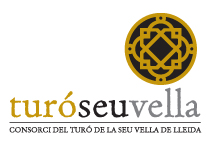With a height of sixty meters, the tower is an absolute adventure. It has a spiral staircase with 238 steps that enables reaching its summit. The panoramic, unique and unrepeatable, is the reward for such boldness.
Located in the southwest corner of the cloister, it was built between the second half of the 14th century and the first third of the 15th century. It has an octagonal floor plan and its outer structure consists of two bodies, one is very tall and thick with windows that progressively gain prominence, and another body that is smaller with narrow crowned gables. In terms of its interior structure, the stairwell and its different floors with various uses standout. The ground floor was converted into a private chapel for the Safont family, while the other floors were allocated to the machinery of the clock and the bells.
According to old records, there were eleven bells that announced holidays and days of mourning, although today only two remain, Silvestra, from 1418, and Monica, from 1486, the year in which the timetable bells were mechanized. A further set of five bells, cast in the mid-twentieth century, ring together for celebrations set out in the calendar. Their names are Bàrbara, Crist, Marieta, Meuca and Puríssima.





